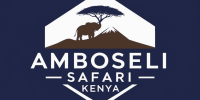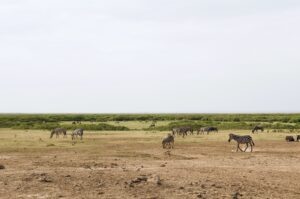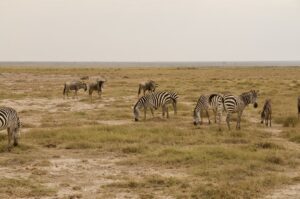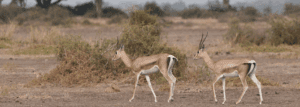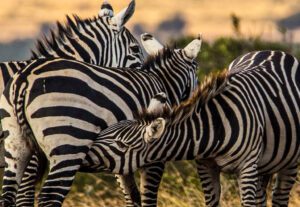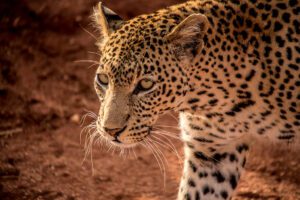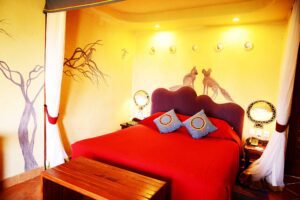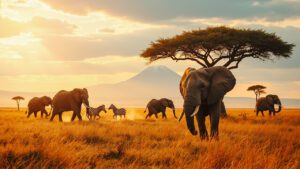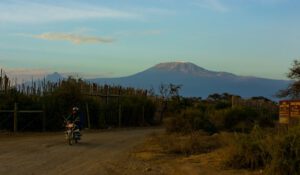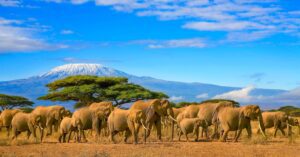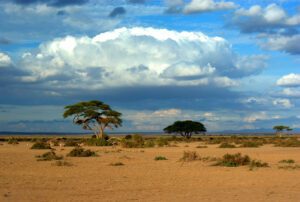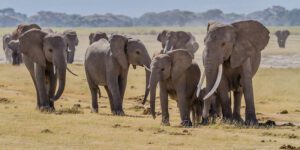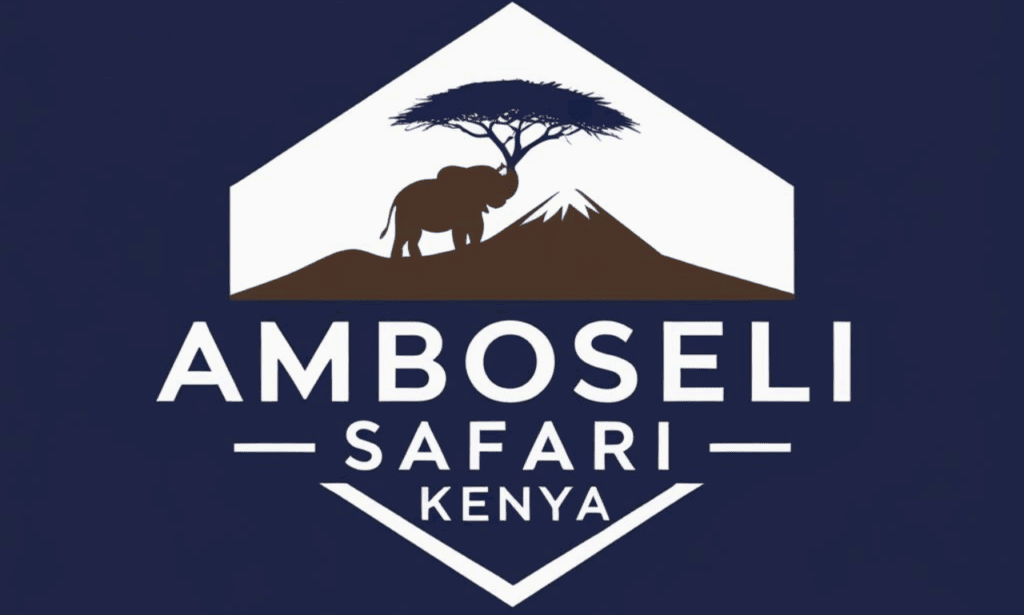What is Amboseli National Park known for, and why should I visit it?
Amboseli National Park, located in Kenya, is famous for its stunning views of Mount Kilimanjaro, Africa’s tallest mountain, and its incredible wildlife. This park is often referred to as the “Land of the Giants” because it is one of the best places in the world to experience an Africa Kenya safari focused on African elephants. Here, large herds of elephants can be spotted roaming freely, often against the breathtaking backdrop of snow-capped Mount Kilimanjaro. It’s a mesmerizing sight!
The park also features a unique ecosystem made up of open plains, acacia woodland, swamps, and dry lake beds. This diversity supports a wide range of wildlife, making it a must-visit for nature enthusiasts. In addition to elephants, Amboseli is home to lions, cheetahs, zebras, wildebeests, giraffes, buffaloes, and an abundance of Kenya birds. It’s an incredible place for anyone who loves animals and wants to witness them in their natural habitat.
One reason to choose Amboseli for your safari adventure is its accessibility. It’s located just a few hours’ drive from Nairobi, Kenya’s capital, making it a perfect safari destination even for short trips. You also get the chance to meet the local Maasai people, who live near the park. Their villages and traditions provide a rich cultural experience, making your visit even more memorable.
If you’re into photography, Amboseli is a dream destination. The combination of wildlife, Mount Kilimanjaro, and golden sunsets makes it one of the most photographed places in Africa. Simply put, Amboseli offers a unique mix of natural beauty, wildlife, and cultural heritage that makes it a must-see destination for any safari enthusiast.
What are the main attractions and wildlife to see during a 2-day Amboseli safari?
During a 2-day Amboseli national park safari, you’ll experience some of the most captivating wildlife and landscapes Africa has to offer. The park’s top attraction is its large population of elephants. You’ll likely see the majestic elephants in herds, walking calmly across the open plains or bathing in the marshy swamps. These elephants are known to be incredibly photogenic, especially when seen with the looming Mount Kilimanjaro in the background.
Other major wildlife attractions include big cats like lions and cheetahs, which you might spot hunting for prey. Giraffes elegantly move across the plains, while zebras and wildebeests graze peacefully in the fields. Buffaloes and hyenas are also common, and there’s a good chance you’ll see hippos in the wetlands. Birdwatchers will be thrilled with Amboseli too, it’s home to over 400 bird species, including flamingos, egrets, and pelicans.
The swamps in Amboseli are fascinating features. These permanent wetlands, fed by Mount Kilimanjaro’s underground water sources, act as life-saving oases for animals during the dry season. This creates an incredible opportunity to watch diverse ecosystems gather at the swamps, especially during the hotter parts of the day when they come to cool down and drink.
You can also enjoy the park’s scenic landscapes, like the dusty, dry lake beds and wide-open grasslands that seem to stretch endlessly. The views of Mount Kilimanjaro throughout your trip add a sense of wonder and make every moment feel special, enhancing your overall safari adventure.
The cultural experiences are another highlight. Many safaris include a visit to a Maasai village, where you can learn about the traditions and way of life of the Maasai people. These encounters add a cultural layer to your trip, giving you more insight into the region you’re exploring.
A 2-day safari might sound short, but it’s just enough time to experience Amboseli’s magic: peaceful elephants, iconic landscapes, and lively ecosystems all make for an unforgettable adventure in this popular park.
How do I get to Amboseli National Park from Nairobi or other locations?
There are two main ways to get to Amboseli National Park from Nairobi: by road or by air. Each option has its own benefits, depending on your time and budget.
By road, the distance between Nairobi and Amboseli is roughly 240 kilometers (about 150 miles) and takes around 4-5 hours, depending on traffic and road conditions. Most travelers take this route as it’s more affordable and allows you to enjoy Kenya’s countryside along the way. You’ll drive through small towns and rural villages, which offer a glimpse into everyday life in Kenya. Tour operators often provide comfortable safari vehicles for the journey, specifically 4×4 Land Cruisers or safari vans, which are suited for both the roads and game drives in the park.
For those who prefer a faster option, you can take a domestic flight from Wilson Airport in Nairobi to Amboseli’s airstrip. Flying takes around 45 minutes, making it the quickest way to get there, and you’ll enjoy aerial views of Mount Kilimanjaro and the surrounding landscapes along the way. This option is more expensive than driving but ideal for travelers on a tight schedule or those who prefer to avoid long road trips.
From other locations, such as Mombasa or the Maasai Mara, you may need to coordinate flights or longer drives, often connecting through Nairobi. It’s a good idea to work with a safari operator to manage transportation logistics, they’ll often include transfers and timing that ensures you can maximize your time in the park.
No matter which method you choose, arriving in Amboseli feels like stepping into another world where wildlife and nature take center stage. The journey to the park is part of the adventure, adding a layer of excitement as you anticipate the magical experiences that await you there.
What is the best time of year to visit Amboseli for a safari?
Amboseli National Park is best visited during the dry seasons, which occur from June to October and January to February. Let me explain why this is the best time and what makes it special.
During the dry season, there is very little rain, which means animals are easier to spot. When it’s raining, water is available everywhere, so animals tend to spread out and may be harder to find. But in the dry season, animals gather around permanent water sources like swamps and lakes within the park. Amboseli is famous for its swamps that stay lush year-round because of underground water flowing from Mount Kilimanjaro. This makes it a hotspot for wildlife during dry months.
For example, you’ll see herds of elephants, one of Amboseli’s most famous residents, enjoying the swamps. Lions, giraffes, zebras, wildebeests, and hundreds of bird species are also much easier to observe in the dry, open landscapes.
Additionally, the skies are mostly clear, so you’re more likely to get stunning views of Mount Kilimanjaro, which serves as a breathtaking backdrop to your safari. This snow-capped mountain is especially visible early in the morning during dry months. If you’re chasing that “classic African safari photo” with elephants and Kilimanjaro in the background, this is the perfect time to visit.
Avoid the long rainy season (March to May) because the roads can get muddy, and wildlife is harder to spot as the tall grass grows. Plus, heavy rains might make safari drives less enjoyable. In short, plan your visit during the dry season to maximize wildlife sightings and overall experience!
What is included in a typical 2-day Amboseli safari itinerary?
A 2-day Amboseli safari itinerary includes exciting activities and highlights designed to give you a rich wildlife and nature experience. Let me walk you through what to expect.
Day 1 usually starts with an early morning departure from Nairobi (or wherever you’re coming from). You’ll be driven to Amboseli National Park, a journey that takes about 4-5 hours. Most safaris include transportation in a safari vehicle with a pop-up roof for excellent game viewing.
Once you arrive, you’ll check into your chosen accommodation, whether it’s a lodge or a tented camp. Afterward, you’ll enjoy your first game drive, typically in the afternoon. This is when you’ll start seeing Amboseli’s famous wildlife: large herds of elephants, lions, cheetahs, zebras, and more. You might even spot hippos in the swamps or vibrant flamingos in the lakes.
Day 2 usually begins with an early morning game drive. Animals are most active during dawn when it’s cooler, so expect to see predators hunting or grazing herbivores like wildebeests and giraffes. After this thrilling drive, you’ll return to your accommodation for breakfast and some relaxation. Depending on the tour, you might have an optional nature walk or cultural visit to a local Maasai village, where you can learn about their traditions and lifestyle.
After an early lunch, you’ll enjoy a final game drive and then depart Amboseli for Nairobi, arriving by evening. This concise itinerary balances adventure, wildlife viewing, and even a cultural touch. It’s a great option for anyone short on time but still looking to experience the beauty of Amboseli!
Are accommodations included, and what are the options (lodges, camps, etc.)?
Yes, accommodations are usually included in a 2-day Amboseli safari package. The type of accommodation depends on what you prefer and your budget, but there are typically three main categories: luxury lodges, mid-range tented camps, and budget-friendly campsites.
Luxury lodges offer the most comfort and amenities, like spacious rooms, hot showers, fine dining, and sometimes even swimming pools. Examples include Ol Tukai Lodge and Amboseli Serena Safari Lodge, which are known for amazing views of Mount Kilimanjaro right from your window or veranda. They’re perfect if you want a little extra indulgence while still enjoying the wilderness.
Mid-range tented camps provide a mix of comfort and a more “wild” experience. These are permanent, canvas tents that give you the feeling of camping but come with proper beds and en-suite bathrooms. Examples include Kibo Safari Camp and Sentrim Amboseli Camp. You can expect delicious meals and great service, making these an excellent choice for most travelers.
Budget-friendly camps are for adventurous travelers who don’t mind basic facilities. These options may include small mobile campsites or hostels nearby. While they don’t have as many luxuries, they still allow you to enjoy the Amboseli experience without breaking the bank.
No matter what you choose, all accommodations are strategically located near game-viewing areas, so you’re never far from the action. Meals are generally included, and the accommodations are part of what creates a memorable safari. Whether you want luxury or simplicity, Amboseli offers something for every traveler!
What kind of transportation is used during the safari?
For an amazing safari adventure in Amboseli National Park, the most common type of transportation is specially designed safari vehicles, like 4×4 Land Cruisers and safari vans. These vehicles are built to handle the rough, unpaved roads in Amboseli NP, ensuring a smooth and safe ride even in the wild terrain.
Safari vehicles are typically customized for game drives. They have open roofs or pop-up tops, allowing you to stand up and get an unobstructed view of the African wildlife and landscape while remaining protected. Open sides or large windows also provide excellent photography opportunities during your exploration.
A 4×4 Land Cruiser is the most popular option because it’s sturdy and can handle muddy or bumpy roads, especially in the rainy season. They usually have seating for around six passengers, meaning everyone gets a window seat! While slightly more expensive than safari vans, they offer a more comfortable ride and are better suited for tough terrain.
Safari vans are another option, typically cheaper than Land Cruisers. These vans have pop-up roofs too and are great for regular safaris when the weather is dry and the roads are less challenging.
In addition to ground travel, some safaris include light aircraft flights to Amboseli if you’re coming from another game park or city in Kenya. This cuts down on travel time significantly but costs much more than road transport.
Pro tip: The vehicle is a huge part of your safari experience, so confirm in advance what type of vehicle will be used through your tour operator to ensure the perfect safari.
How long are the game drives, and how many game drives are included in two days?
In a typical 2-day Amboseli safari, you can expect two to four game drives in total, usually lasting 2–4 hours each.
Day 1 usually includes one game drive, often in the afternoon, after you arrive at the park. This will give you a chance to explore the park when animals are more active as the temperatures cool down. Lions, cheetahs, and elephants may be spotted as they hunt, graze, or wander around.
Day 2 will likely have two game drives, one early in the morning and another in the mid-morning or afternoon. The early morning game drive is considered the best because it’s cooler, and many animals, like elephants and predators, tend to be more active during this time. You’ll also have stunning views of Mount Kilimanjaro as the sun rises (weather permitting).
Each game drive is an opportunity to explore a different part of the park. Amboseli is famous for its variety of wildlife, including gigantic elephant herds, giraffes, lions, buffalos, zebras, hyenas, and over 400 bird species like flamingos and pelicans.
If you have specific animals you want to see, communicate with your guide before the game drives. Your guide is familiar with the park’s layout and animal behaviors and will do their best to meet your preferences.
What should I pack or prepare for a 2-day Amboseli expedition?
Packing the right items for a 2-day Amboseli safari is crucial to ensure a comfortable and enjoyable trip. Here’s what you should bring:
- Clothing: Bring lightweight, breathable clothes in neutral colors (like khaki, olive, or beige) to blend in with the environment. Avoid bright colors that could scare animals. Pack layers, as it can be chilly during early morning and evening game drives and warm during the day. A lightweight jacket or fleece is great, along with a wide-brimmed hat for sun protection.
- Comfortable Shoes: You won’t do much walking, but sturdy, comfortable shoes or sneakers are ideal for getting in and out of vehicles and walking short distances.
- Sun Protection: Sunscreen, sunglasses, and a hat are essential because the sun in Kenya can be intense, even in the early hours.
- Camera and Binoculars: You’ll want to capture memorable moments, so pack a good camera or smartphone with enough storage. Binoculars are useful for spotting distant animals.
- Reusable Water Bottle and Snacks: While most safaris include drinks, it’s always good to have your reusable water bottle to stay hydrated. Lightweight snacks like nuts or granola bars can also come in handy.
- Insect Repellent: Amboseli is not known for high malaria risk, but bringing insect repellent can help you avoid insect bites, particularly in the evening.
- Travel Documents: Carry a valid passport (if not a Kenyan resident), travel insurance documents, and confirmation of your safari booking. Don’t forget your park entry permit if it’s not included in your tour package.
- Cash for Tips: It’s customary to tip your guide and driver for their efforts, so budget a little cash to show your appreciation.
- Medications and First Aid Kit: Pack any personal medications, like antihistamines or motion sickness tablets, and a small first aid kit for emergencies.
By preparing these essentials, you’ll be well-equipped to enjoy your Amboseli safari to the fullest, whether it’s spotting an elephant herd or marveling at the majestic Mount Kilimanjaro!
Are meals and beverages provided as part of the itinerary?
Yes, most 2-day Amboseli safari packages typically include meals and beverages as part of the itinerary. Since a safari involves a lot of time traveling and exploring remote areas, meals are an important inclusion to ensure that you can focus on enjoying the experience without worrying about where to eat.
Meals are usually provided by the lodge or camp where you’re staying as part of your accommodation package. On the first day, you’ll often start with lunch (if you arrive midday) and enjoy a full dinner later on. The second day usually includes breakfast before embarking on a game drive and may also offer lunch, depending on how the itinerary is structured.
For example, if you stay at a luxury lodge, you might be served a buffet breakfast, a three-course meal for lunch, and a hearty dinner in the evening. If you’re in a tented camp or on a more budget-friendly safari, you’ll still be provided with well-prepared meals that meet your dietary preferences (you can inform the operator in advance of any dietary restrictions).
Beverages vary slightly depending on the package. Water is always provided, as staying hydrated during game drives under the sun is vital. Some lodges include tea, coffee, and soft drinks with meals, while alcoholic drinks may come at an extra cost unless you’re on an all-inclusive package.
Make sure to confirm the specifics with your safari operator, as the details of what’s included can vary slightly. And, if you’d like snacks or specific drinks during game drives, it’s a good idea to bring along some extras (or purchase them in advance) for your comfort.
Is a guide provided, and what is their role during the safari?
Yes, a professional safari guide is almost always provided as part of a private safari package in Amboseli National Park. This guide plays an essential role in making your experience smooth, enjoyable, and educational.
First and foremost, your guide is an expert in African wildlife and the Amboseli ecosystem. They are trained to spot animals, identify bird species, and interpret animal behavior that you might otherwise miss. For example, while you might see majestic elephants in the distance, a guide can bring your attention to fascinating details like how they communicate with each other or why they’re traveling in groups.
Your guide also navigates the park’s roads, tracks, and terrain. Amboseli can have rough, bumpy roads, so having an experienced driver-guide ensures your safety and makes the safari comfortable. They know the best routes to take, where certain animals are likely to be found, and when you’re likely to see special sights like a lion on a hunt or a cheetah lounging in the shade.
Guides often share detailed stories and fun facts about Amboseli’s history, culture, and conservation efforts. For example, they might talk about how Amboseli is famous for its large-tusked elephants, or how Mount Kilimanjaro creates the park’s iconic backdrop. This knowledge adds depth to your safari adventure, turning it into more than just a sightseeing trip, it becomes an educational experience.
Lastly, your guide ensures you follow park rules and respect the environment. They’ll remind you of important things like staying in the vehicle for safety, keeping noise levels down to avoid disturbing the animals, and avoiding littering.
In summary, a guide doesn’t just “drive you around”, they are your educator, navigator, storyteller, and protector all rolled into one. Their insights can elevate your Amboseli national park safari from memorable to truly unforgettable!
Are there additional costs, such as park fees, that I should budget for?
Yes, additional costs such as park fees are common when visiting Amboseli National Park, and it’s important to budget for them in advance. Park fees, charged by the Kenya Wildlife Service (KWS), contribute to the upkeep of the park and conservation of wildlife. If you’re planning an Africa Kenya safari, understanding these fees is essential for a smooth experience.
The entrance fees vary based on your residency status. As of 2023, international visitors pay USD $60 per adult per day and USD $35 per child per day. Residents of East African countries generally pay lower fees, such as KES 860 for adults. Keep in mind these fees can change, so always confirm the most up-to-date rates with your safari operator or directly with KWS before you depart Nairobi.
If your safari itinerary explicitly states that park fees are included in the overall cost, then you don’t need to worry about them. However, with some budget or customized packages, park fees may be excluded and need to be paid separately, typically in cash or by card upon arrival at the park entrance.
Apart from park fees, there are a few other potential additional costs to consider. For instance, alcoholic beverages, optional activities (like a hot air balloon ride), or souvenirs from the lodge shop will not be included in your package. You might also want to tip your safari guide or lodge staff, a common practice in Kenya; the typical range for tips is $10–$15 per day for the guide, especially during your safari adventure.
In summary, park fees and some extras (like tips, drinks, or souvenirs) are additional expenses you should factor into your budget. Always clarify what’s included in your safari package to avoid unexpected costs, ensuring a memorable experience in this popular park.
